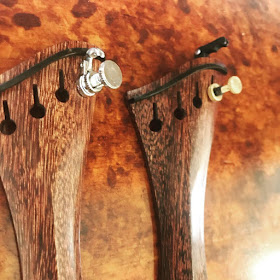By Andy Fein, Luthier at www.FineViolins.com
and Ivana Truong
Is the E the most problematic string on your violin? Yes? Don't worry, you're not alone.
 |
| An 'Evah Pirazzi loop-end E string (right) & a Thomastik 'Special Program' Gold E (left) |
And then there's the question of loop end or ball end. What's the difference? In my opinion, loop end E strings break more often. MUCH more often. You can use the cool Hill/English style E string tuner when you have a loop end E, but I don't think the small perceived tonality difference is worth the trail of broken E strings.
 |
| Ball end on the left, loop-end on the right |
If you use one of the carbon composite tailpieces with four fine tuners built in, then you need ball end strings.
No matter which E string tuner you use, occasionally check to make sure it's tight enough on the tailpiece so that it doesn't rattle when you play.
 |
| Hill Style tuner |
 |
| If you use a carbon composite tailpiece with integrated fine tuners, you have to use ball-end strings |
 |
| Uni-style tuner on the left, Post-style tuner on the right |
Pirastro has a great chart summarizing all the differences in their E strings.
E strings can be broken down into two categories:
1) Plain Steel E strings. These are usually coated with another metal: tin, silver, gold, platinum, or an alloy.
2) Wound E strings. These E strings have a steel core and are then wound with a very thin layer of chrome, aluminum, or some magic combination of metal and nylon.
First, the "Kaplan Solutions Non-whistling E". This is a wound E string that is engineered not to whistle or hiss. Ever have your E string screech during a string transition? C'mon! Most of us have. This Kaplan Solutions Non-whistling E won't screech. Or, you have to try really hard to make it screech. It's a ball end string and it comes with a little extender if you have loop end style tuner. We use this E string on 90% of our violins. Kudos to Kaplan for also coming up with one of the longest names for an E string!
Pirastro makes a very similar E string, the "No. 1 Universal". They also tout the advantage that the winding on the core is chrome steel and won't be affected by hand perspiration. The Pirastro No.1 Universal is available with both a loop or a ball end.
If you don't want to use a wound E, two old standards work great. The Westminster E in a 26 gauge, which means it is .26mm in diameter, or the medium (26) gauge Pirastro Gold Steel E. Both are medium gauge and made from tin-plated steel. Simple strings that work and sound great! They're available in both ball and loop end. Branding can be confusing- the Pirastro GOLD E string is NOT plated with gold. The name harkens back to distinctions of sets of Pirastro gut core strings- Black, Gold, and Eudoxa. You can use the Pirastro Gold E with any nylon core strings such as Evah Pirazzi, Dominant, or Kaplan.
 |
| Pirastro Gold Steel E |
If you want a less mellow sound, you can explore different gold plated E-strings. Gold plated E-strings tend to be better for players who want more power. Some gold E-strings that work great are the Pirastro Evah Pirazzi Gold E and the Thomastik-Infeld Vienna (or Special Program) Gold E. If you have trouble with squeaking on string transitions, you can try platinum E-strings. They're more expensive, but they offer a soloist sound similar to the gold E-strings without as much of a tendency to squeak.
 |
| Thomastik Special |
If you need a more mellow, less bright sound, you can try lighter gauge (.25) E-strings. Since they are usually lighter tension, they feel easier under the fingers, making them a bit easier to play. However, they project less, meaning they are less loud.
At the end of the day, each instrument and each player will work differently with each E string. Using some of these general guidelines can help you adjust and find the sound you want for your violin.
Here's some good E string trivia you can bring up to wow your friends at the next violinist coffee klatch- most tinned E strings of the same gauge or tension (.26 or medium, let's say) are EXACTLY the same. That holds true even more within each manufacturer. That is, the medium gauge tinned steel Pirastro 'Evah Pirazzi' E is the same as a Pirastro 'Gold' E. They just put different wrappings on the string so that it looks like the rest of the set. This will also save you in a pinch when you need a new E string in an emergency and the local shop is out of Pirazzi steel Es. Go ahead and use a different Pirastro steel E, or even a Westminster E or Kaplan Vivo steel E. As long as the gauge is the same (medium= 26) they're the exact same string or very close to it.
Have a solo coming up and you really need the most powerful, clearest, projecting E string available? I recommend the 'Peter Infeld Pi' E. Just don't try playing Haydn quartets in an intimate setting with it.
 |
| Peter Infeld Platinum E |
Can you put them on yourself? You can take advantage of our 'Grab and Go' pricing and get an extra 30% Off our already discounted prices.


Hi! Pirastro’s website actually indicates that the Evah Pirazzi ‘silvery steel’ E is made of a different type of steel, and has different tensions in each gauge, than the Gold Label E.
ReplyDeletehttps://mobile.pirastro.com/public_pirastro/pages/en/E-Strings/